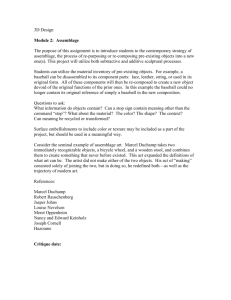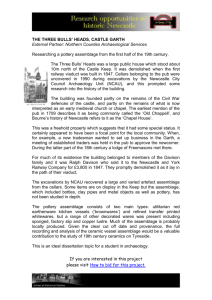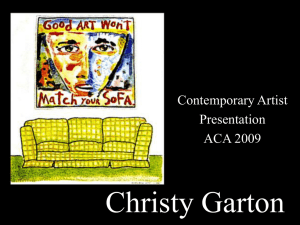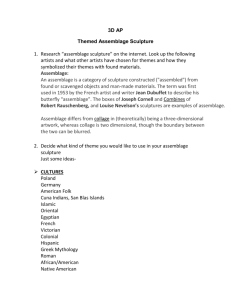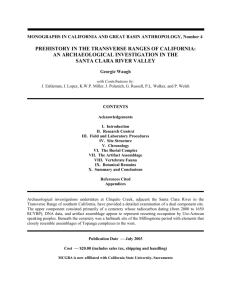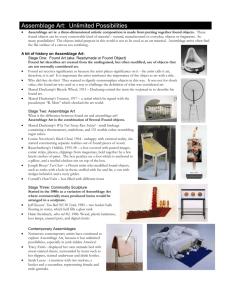post-tour-project - Orange County Museum of Art
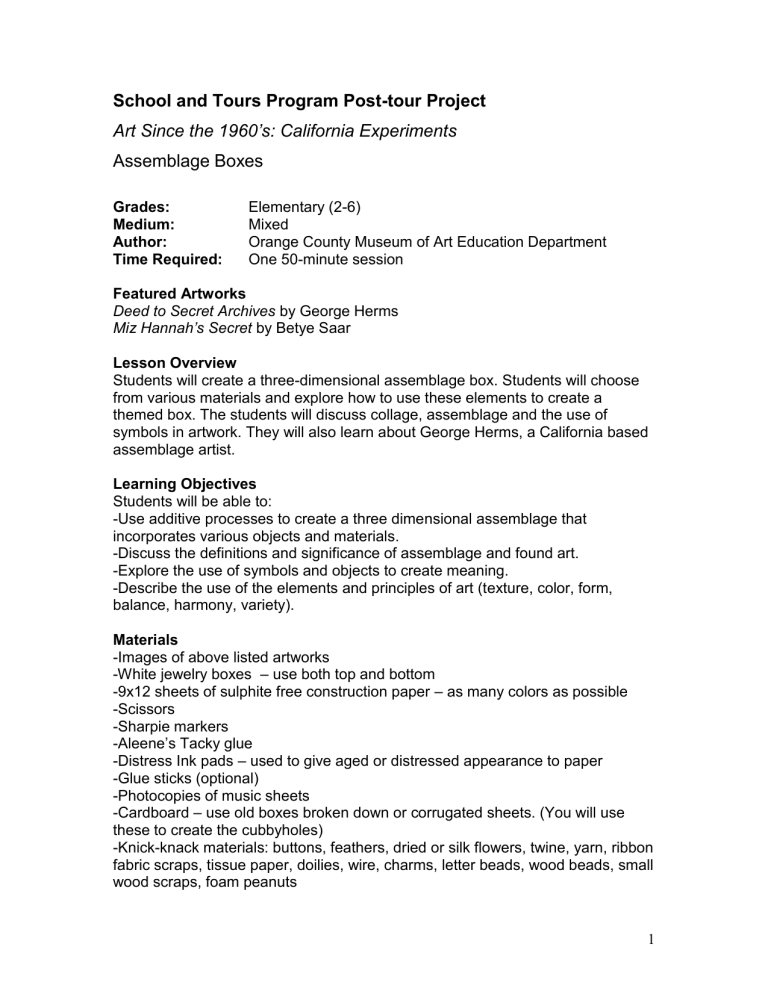
School and Tours Program Post-tour Project
Art Since the 1960’s: California Experiments
Assemblage Boxes
Grades:
Medium:
Author:
Elementary (2-6)
Mixed
Orange County Museum of Art Education Department
Time Required: One 50-minute session
Featured Artworks
Deed to Secret Archives by George Herms
Miz Hannah’s Secret
by Betye Saar
Lesson Overview
Students will create a three-dimensional assemblage box. Students will choose from various materials and explore how to use these elements to create a themed box. The students will discuss collage, assemblage and the use of symbols in artwork. They will also learn about George Herms, a California based assemblage artist.
Learning Objectives
Students will be able to:
-Use additive processes to create a three dimensional assemblage that incorporates various objects and materials.
-Discuss the definitions and significance of assemblage and found art.
-Explore the use of symbols and objects to create meaning.
-Describe the use of the elements and principles of art (texture, color, form, balance, harmony, variety).
Materials
-Images of above listed artworks
-White jewelry boxes – use both top and bottom
-9x12 sheets of sulphite free construction paper
– as many colors as possible
-Scissors
-Sharpie markers
-
Aleene’s Tacky glue
-Distress Ink pads – used to give aged or distressed appearance to paper
-Glue sticks (optional)
-Photocopies of music sheets
-Cardboard
– use old boxes broken down or corrugated sheets. (You will use these to create the cubbyholes)
-Knick-knack materials: buttons, feathers, dried or silk flowers, twine, yarn, ribbon fabric scraps, tissue paper, doilies, wire, charms, letter beads, wood beads, small wood scraps, foam peanuts
1
Preparation
-Order jewelry boxes (Papermart.com)
-Cut strips of corrugated cardboard that fit the depth of the boxes. These will be used to create the cubbyholes.
-Set up various containers with a variety of objects and materials.
Glossary
Assemblage: an artistic composition made from scraps, junk, and odds and ends (as of paper, cloth, wood, stone, or metal); the art of making assemblages.
Collage: the technique and the resulting work of art in which pieces of paper, photographs, fabric and other ephemera are arranged and stuck down to a supporting surface.
Symbol: something used for or regarded as representing something else; a material object representing something, often something immaterial; emblem, token, or sign.
Identity: the distinguishing character or personality of an individual.
Additive sculpture: a physical object constructed from separate parts which have been connected using glues, joints, stitching, welds and so on.
Lesson Steps
1. Begin the class by showing a few selected images of works by George Herms,
Betye Saar and Joseph Cornell. Ask the students to share their reactions to each work. Ask students to describe what they see in each of the art works. Discuss the fact that these artists use collected and found objects to create their art. Ask students why they think the artists do this. Ask students if anyone collects anything and why. Ask what they think collecting these objects tells us about them.
Show an example of assemblage box. Ask students to choose objects and materials when creating their box that tell us something about them.
2. Hand out boxes.
3. Demonstrate how to begin the box. Make sure students are aware that they need to put background fabric and/or paper inside before they create the cubbyholes.
4. Demonstrate how to use the cardboard pieces to create cubbyholes. Discuss with the students that each cubbyhole should have meaning or a story behind it.
4. Have fun!
2
Visual Arts Content Standards:
Artistic Perception
Processing, analyzing, and responding to sensory information through the language and skills unique to the visual arts.
2.1.2
4.1.5
5.1.2
Creative Expression
Creating, performing and participating in the visual arts.
2.2.1
4.2.3
5.2.5
5.2.7
Historical and Cultural Context
Understanding the historical contributions and cultural dimensions of the visual arts.
2.3.1
3.3.2
4.3.2
Aesthetic Valuing
Responding to, analyzing and making judgments about works in the visual arts.
2.3.1
4.3.2
4.4.3
4.4.5
3
VISUAL ARTS VOCABULARY AND DEFINITIONS:
Elements of art
1. Line
– a continuous mark made on a surface.
2. Shape – an enclosed two-dimensional area.
Geometric
– circle, square, rectangle, triangle, etc.
Organic
– natural form.
3. Color – created by light reflecting off objects. The primary colors are red, blue and yellow.
4. Value
– lightness or darkness of an area.
5. Texture – the surface quality or feel of an object.
6. Space – the area between, around, above, below or within things.
Principles of art
1. Rhythm and Movement – the visual flow through a work of art, incorporating repetition (the occurrence of elements at regular intervals).
2. Balance
– combining elements to create a sense of unity or stability.
Symmetry – the balancing elements are alike and will appear to mirror one another.
Asymmetry
– a balance achieved through use of unequal parts or elements.
3. Harmony – combining similar elements to accent their similarities.
4. Proportion
– the relationship of certain elements to the whole and each other, such as large next to small.
5. Variety – combining elements to create intricate and complicated relationships.
6. Emphasis or contrast
– combining elements to stress the differences. – used to make something stand out, like dark next to light.
7. Gradation – combining elements by using a series of gradual changes in those elements.
4


